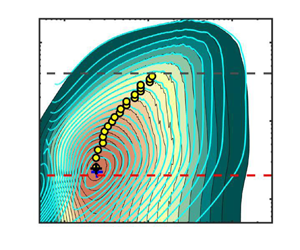Article contents
Taylor's frozen hypothesis of the pressure fluctuations in turbulent channel flow at high Reynolds numbers
Published online by Cambridge University Press: 29 September 2023
Abstract

We study the application of Taylor's frozen hypothesis to the pressure fluctuations in turbulent channels by means of spatio-temporal data from direct numerical simulations with large computational domains up to the friction Reynolds number  $R{e_\tau } = 2000$. The applicability of the hypothesis is quantitatively verified by comparing the wavenumber and Taylor (frequency) premultiplied spectra of the pressure fluctuations at each distance y from the wall. Using the local mean velocity
$R{e_\tau } = 2000$. The applicability of the hypothesis is quantitatively verified by comparing the wavenumber and Taylor (frequency) premultiplied spectra of the pressure fluctuations at each distance y from the wall. Using the local mean velocity  $U(y)$ for the hypothesis leads to a large difference between both spectra with a value of
$U(y)$ for the hypothesis leads to a large difference between both spectra with a value of  $O(50\,{\%})$ for its maximum from the wall to
$O(50\,{\%})$ for its maximum from the wall to  $y/h \approx 0.2$, where h is the channel half-depth. Alternatively, the convection velocity of the pressure fluctuations
$y/h \approx 0.2$, where h is the channel half-depth. Alternatively, the convection velocity of the pressure fluctuations  ${C_p}(y)$, originally defined by Del Álamo & Jiménez (J. Fluid Mech., vol. 640, 2009, pp. 5–26) as a function of y, is investigated and adopted for the hypothesis. It is nearly equal to
${C_p}(y)$, originally defined by Del Álamo & Jiménez (J. Fluid Mech., vol. 640, 2009, pp. 5–26) as a function of y, is investigated and adopted for the hypothesis. It is nearly equal to  $U(y)$ from
$U(y)$ from  ${y^ + } = 20$ to the channel centre, where
${y^ + } = 20$ to the channel centre, where  ${y^ + } = y{u_\tau }/\nu $, in which
${y^ + } = y{u_\tau }/\nu $, in which  ${u_\tau }$ and
${u_\tau }$ and  $\nu $ represent the friction velocity and kinematic viscosity, respectively. For
$\nu $ represent the friction velocity and kinematic viscosity, respectively. For  ${y^ + } \le 20$,
${y^ + } \le 20$,  ${C_p}(y)$ is almost constant with a value of around
${C_p}(y)$ is almost constant with a value of around  $12{u_\tau }$. Applying
$12{u_\tau }$. Applying  ${C_p}(y)$ for the hypothesis decreases the difference between both spectra down to a value of
${C_p}(y)$ for the hypothesis decreases the difference between both spectra down to a value of  $O(10\,{\%})$ for its maximum from the wall to
$O(10\,{\%})$ for its maximum from the wall to  $y/h \approx 0.2$. Finally, the difference between the pressure wavenumber and frequency premultiplied spectra near the wall is reduced further via applying a wavenumber-dependent convection velocity. This wavenumber-dependent convection velocity is the linear combination of the convection velocities of the turbulent structures associated with the pressure field weighted by their relative contributions to the pressure variance.
$y/h \approx 0.2$. Finally, the difference between the pressure wavenumber and frequency premultiplied spectra near the wall is reduced further via applying a wavenumber-dependent convection velocity. This wavenumber-dependent convection velocity is the linear combination of the convection velocities of the turbulent structures associated with the pressure field weighted by their relative contributions to the pressure variance.
- Type
- JFM Papers
- Information
- Copyright
- © The Author(s), 2023. Published by Cambridge University Press
References
- 3
- Cited by



